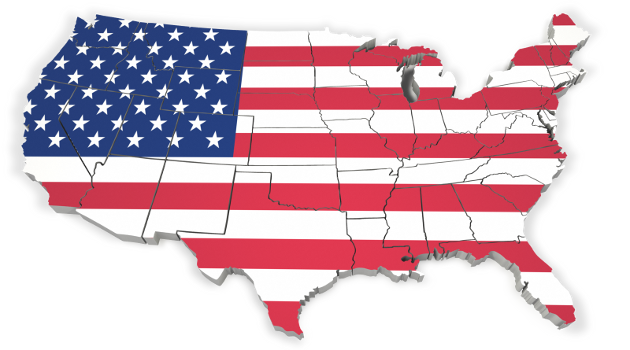Proponents of liberty generally are big fans of federalism. In part, this is simply an issue of “good governance” since both voters and lawmakers at the state and local level are more likely to actually understand the real issues in communities and be able to develop policies that are more sensible.
But we also like federalism because it’s relatively easy for people to move across state and local borders and this means governments have to compete with each other, both in terms of not driving away productive people and also in terms of not attracting those who want to mooch off the government.
The obvious implication is that if we can dramatically shrink the federal government so that it only handles the few (enumerated) powers envisioned by the Founding Fathers, that would give states far more authority to determine tax burdens and the degree of redistribution, and they would presumably do a better job because they would compete with each other for jobs and investment.
This is why I’m always interested when organizations produce rankings that show the degree to which states seem inclined to adopt good policy. For instance, I routinely highlight the findings of the Tax Foundation’s State Business Tax Climate Index so I can see which states have acceptable tax policy. And the Mercatus Center’s Ranking the States by Fiscal Condition is a must-read publication to see which states follow sensible budget policy.
The latest addition to this group is the Cato Institute’s Freedom in the 50 States. It’s a comprehensive publication with lots of data and number-crunching, so wonks will have a field day digging into the details.
But if you simply want the highlights, I first looked to see which states have the best fiscal policy. Here’s the relevant table from the document and I’ve modified it to show which states have no income tax (blue stars), which ones have flat taxes (red stars), and which ones have no sales tax (black stars).
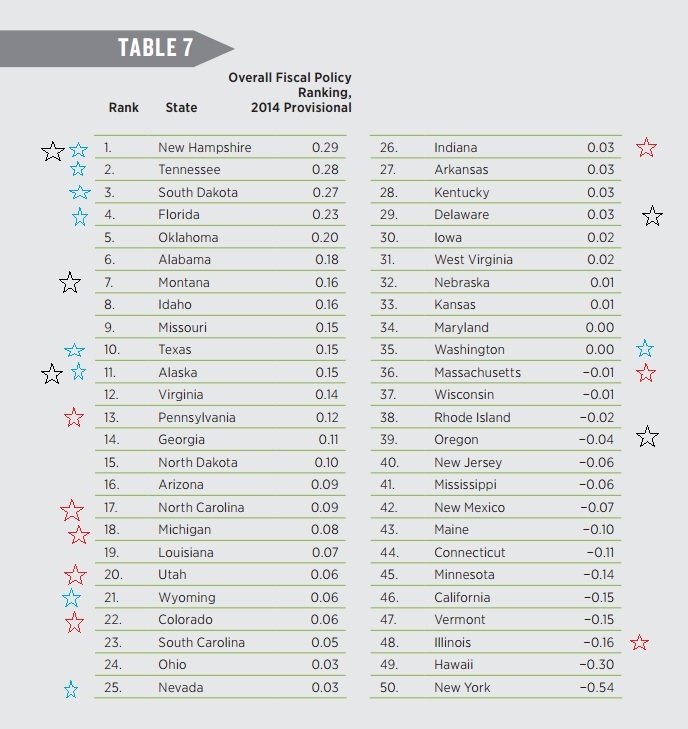
The obvious implication is that having no state income tax is probably the single most important way of controlling the fiscal burden of government.
But fiscal policy is just one variable of economic freedom. And while states obviously don’t have any leeway on monetary policy and trade policy, they have considerable powers over issues related to regulation.
And when you add these factors to the mix, you can get a measure of overall economic freedom.
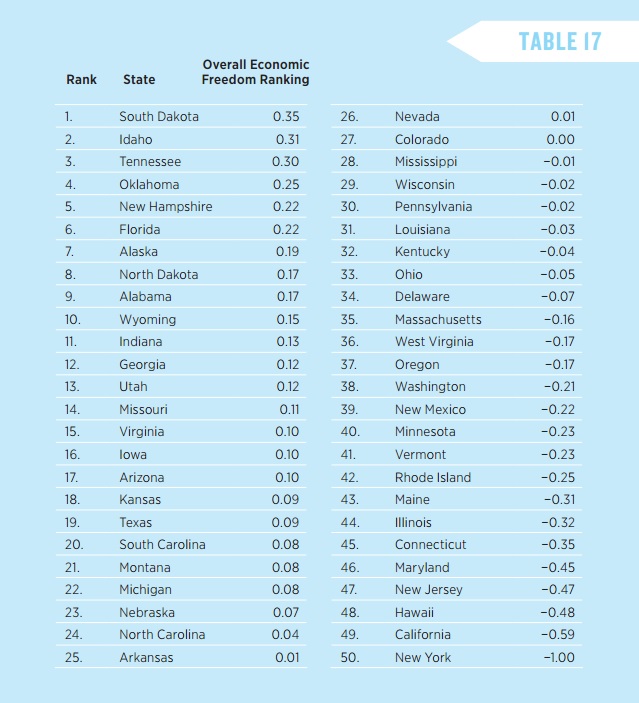
If you compare these first two tables, there are some predictable similarities (New York and California score poorly while South Dakota, Tennessee, and New Hampshire do well).
But you also get some odd results. Pennsylvania, for instance, is 13th for fiscal policy, but drops to 30th for overall economic policy. I guess this means they are regulatory maniacs.
By contrast, Indiana is ranked a mediocre 26th for fiscal policy, but jumps to 11th place for overall economic policy, which presumably means a very laissez-faire approach to red tape.
Now let’s add personal freedom issues to the equation (issues such as guns, gambling, sex, education, booze, and even fireworks).
The bottom line, if you value overall liberty, is that you better be tolerant of cold weather since New Hampshire and Alaska are atop the rankings. New York is in last place by a comfortable margin.
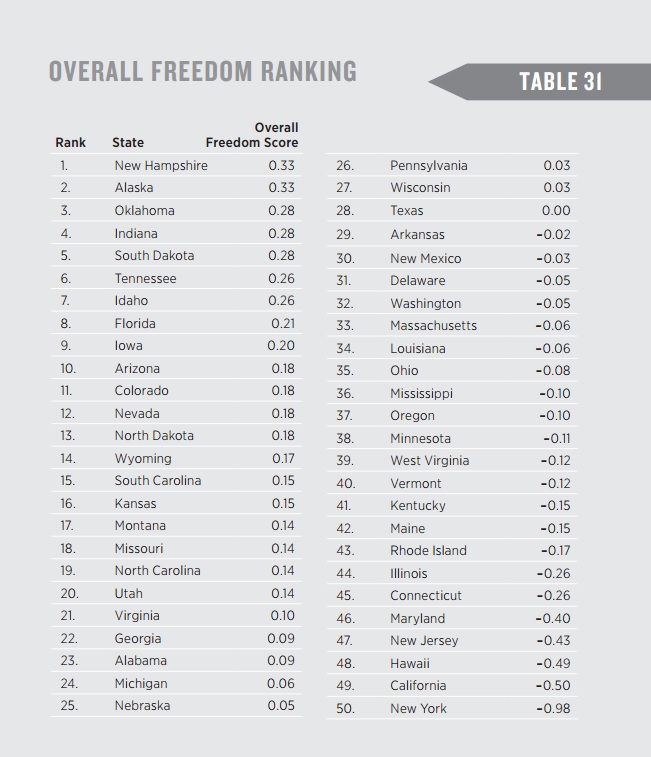
Interestingly, if you compare the fiscal ranking with the above table for overall freedom, you’ll notice that there’s a lot of overlap. New Hampshire is first in both and New York is last, for instance.
But there are some odd anomalies. Iowa, for example is 9th for overall freedom but only 30th for fiscal freedom, a gap of 21 spots. There’s also a big difference for Kansas, which is 33rd in fiscal freedom but 16th for overall freedom.
Conversely, Texas is 10th for fiscal freedom, but drops to 28th place for overall freedom. And Alabama also has a split personality, ranking 6th for fiscal policy but 23rd for overall freedom.
Why are some states bad on fiscal policy but good on regulation and personal freedom, like Iowa and Kansas? Or, in the case of states like Alabama and Texas, the other way around?
Beats me. Maybe some southern states like controlling people’s lives so long as it doesn’t involve the power of the purse (sort of like Singapore). And maybe some farm states exploit the power of the purse, both otherwise leave people alone (sort of like the Nordic nations).
Here’s something easier to understand, a measure of which states have improved the most and deteriorated the most in the 21st century.
The bad news is that only nine states have moved in the right direction, with Oklahoma easily winning the prize for pro-liberty reforms. Honorable mention to Alaska, Maine, and Idaho.
By the way, is anybody surprised that Illinois is in last place? The dropping scores for Hawaii, New Jersey, and Connecticut also aren’t surprising.
But why have Kentucky, Nebraska, and Tennessee fallen so much?
P.S. Since we’re ranking states, here’s one final bit of information.
I wrote recently to debunk the left’s claim that California is an economic success story. My main point was to share per-capita income data from the BEA to who that California has been losing ground  over the medium-term and long-term to states such as Kansas and Texas. And even in the short-term as well if you look at Census Bureau data on median household income.
over the medium-term and long-term to states such as Kansas and Texas. And even in the short-term as well if you look at Census Bureau data on median household income.
But some leftists pushed back by arguing that the numbers nonetheless showed higher income levels in California. That’s certainly what we see in both the BEA and Census data, though I would argue that’s actually not relevant unless one (incorrectly) claims that California became a rich state because of big government. As i wrote in that column, “we’re focusing on changes in per-capita income (i.e., which state is enjoying the most growth, regardless of starting point or how much money can buy in that state).”
Speaking of “how much money can buy,” let’s look at some great work from the Tax Foundation on that topic. If you have $100 of income, where will you be able to buy the best basket of goods and services. As you can see, you’re far better off in Texas or (especially) Kansas than in California.
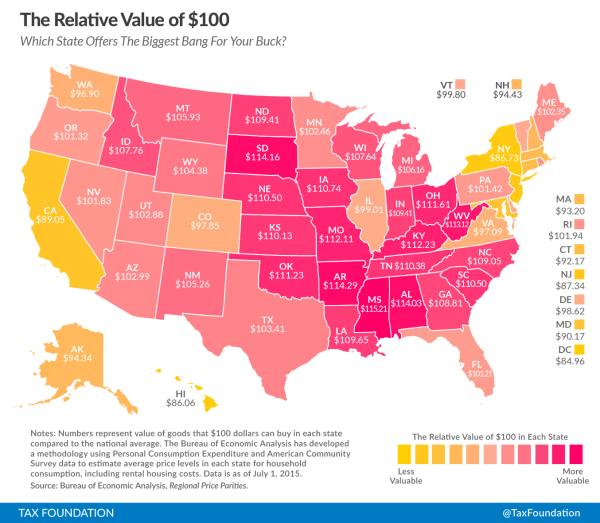
The bottom line is that living standards in Texas and Kansas would be higher than those in California if BEA and Census numbers were adjusted for purchasing power parity (as happens when comparing living standards across nations).
Some people may want to live in California (or some other high-tax state) because of the climate or scenery. They just have to accept lower living standards caused by bigger government. Just like there are certain benefits of living in nations such as France and Italy, but you have to accept bloated government and economic stagnation as part of the package

